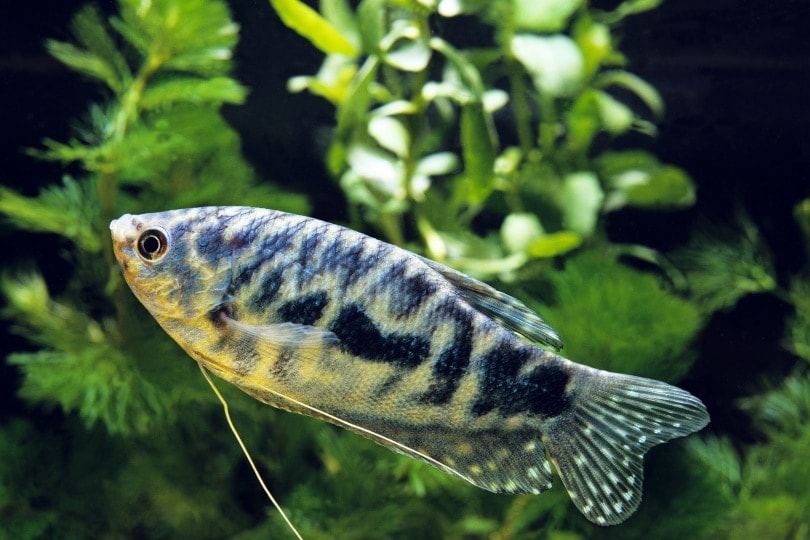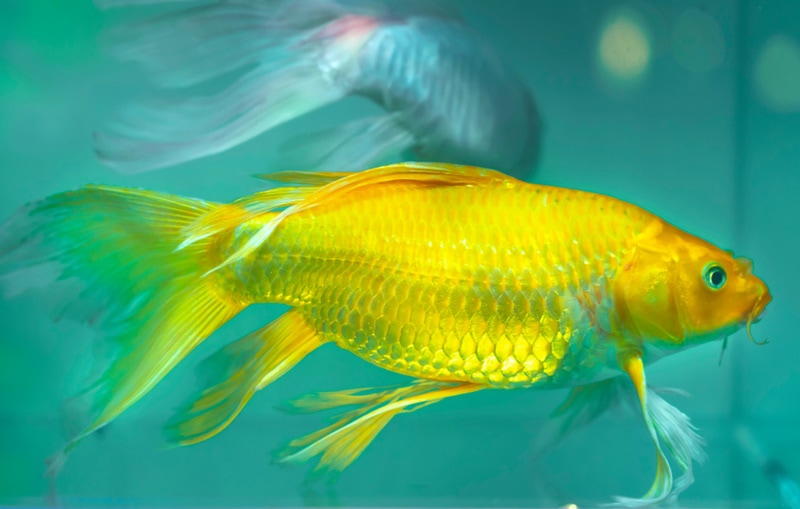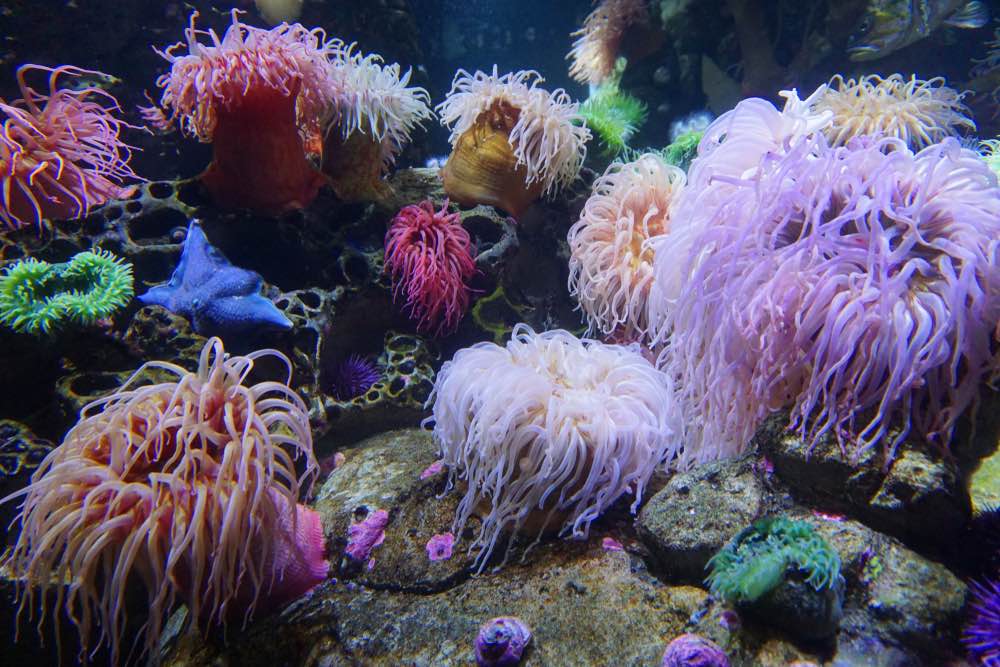10 Great Tank Mates for Glofish Tetras: With Pictures, Facts & Care Guide

Updated on
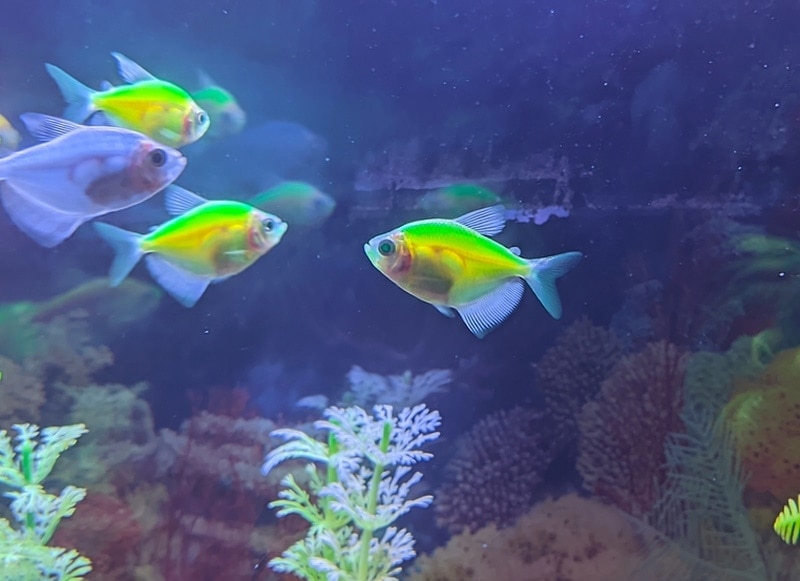
Click to Skip Ahead
Glofish were genetically modified so they would glow when certain waterborne pollutants were present in their environment. Their bright colors and placid nature meant that they soon became available as pet aquarium fish, although they are not available in all countries or regions. Glofish Tetras are just one variety of Glofish, with other species including danios, tetras, and bettas.
Strictly speaking, Glofish are trademarked and the intentional breeding and trading of Glofish is prohibited under the trademark terms. Accidental breeding and keeping of the young is acceptable, however. Below are 10 fish species that can be kept with Glofish Tetra to create an attractive and peaceful home aquarium.
The 10 Best Tank Mates for Glofish Tetras
1. Bristlenose Pleco (Ancistrus cirrhosus)
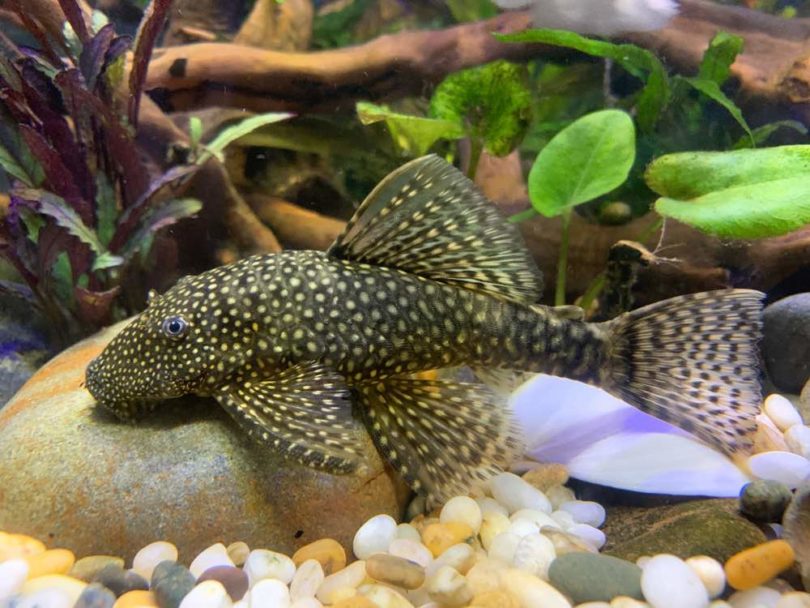
| Size: | 4–5 inches (10–13 cm) |
| Diet: | Herbivore |
| Minimum tank size: | 40 gallon (150 liters) |
| Care Level: | Medium |
| Temperament: | Relaxed |
The herbivorous Bristlenose Pleco eats plant matter and can help keep a tank clear of algae. This catfish species can grow to 5 inches in length but you shouldn’t keep the Bristlenose with other bottom-feeding algae eaters or you will encourage food competition. Feed Bristlenose Plecos additional algae and plant matter by feeding algae tablets or even some fresh spinach or lettuce.
This is a relaxed nocturnal species that will usually get along with other fish in the tank and won’t cause a nuisance to your Glofish. The Pleco generally keeps itself to itself so while Glofish Tetras may reside near the substrate, the two types of fish will not generally cause a problem for one another.
2. Corydora (Corydoras paleatus)
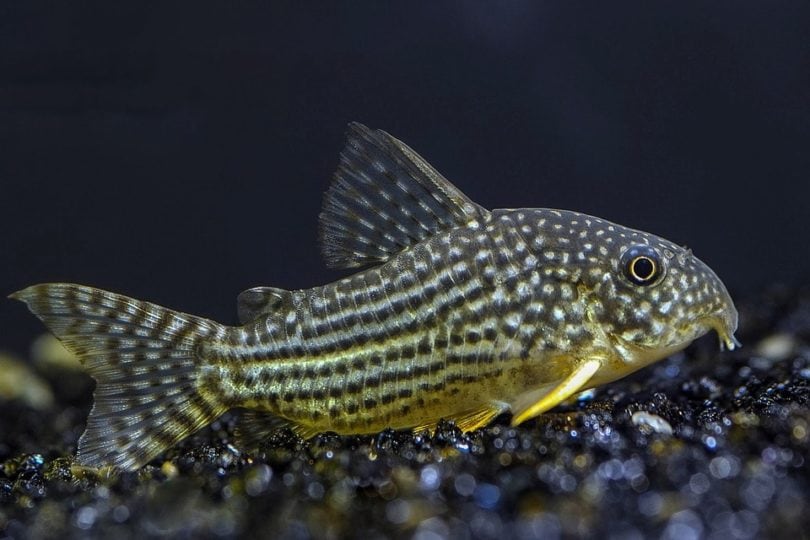
| Size: | 2–5 inches (5–13 cm) |
| Diet: | Omnivore |
| Minimum tank size: | 20 gallons (75 liters) |
| Care Level: | Easy |
| Temperament: | Shy |
Corydoras are another catfish species that eat algae from the substrate and the bottom of the tank. They do a good job of maintaining water quality and keeping the tank clean. They are quite shy fish, so they will stay away from all tankmates including Glofish Tetra, although they won’t necessarily swim away from the Glofish if they approach the substrate.
Although the Corydora does eat waste and algae from the tank, you shouldn’t rely solely on them to maintain cleanliness. You will still need to perform regular water changes and keep the tank clean yourself. The Corydoras themselves are prone to nitrite poisoning, so water cleanliness and tank maintenance are vital.
3. Dwarf Gourami (Trichogaster lalius)
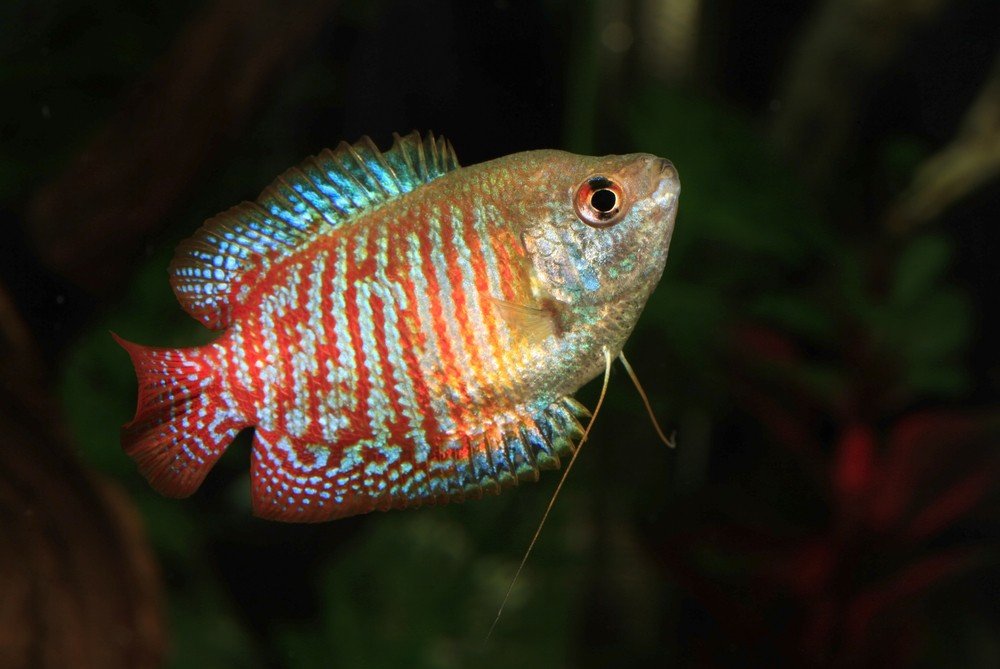
| Size: | 2–3 inches (5–8 cm) |
| Diet: | Omnivore |
| Minimum tank size: | 10 gallons (38 liters) |
| Care Level: | Medium |
| Temperament: | Peaceful |
Dwarf Gouramis dwell around the middle to the top of the tank, not least because they have a labyrinth organ so they need access to the water’s surface to be able to breathe oxygen. Dwarf Gouramis are small fish that only grow to around 2 inches and they prefer to live in schools of six fish or more.
This generally peaceful species will get along with most other fish and because they live near the top of the tank they will rarely come into contact with Glosh Tetras. However, the Dwarf Gourami can become agitated and may attack other fish if kept with especially bright fish.
4. Guppy (Poecilia reticulata)
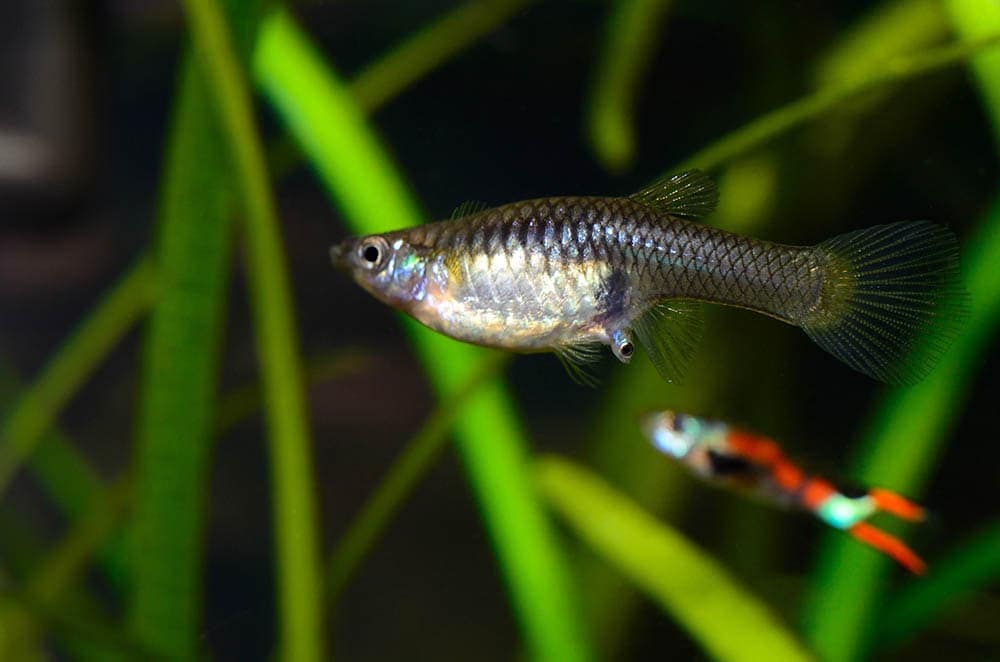
| Size: | 0.5–2.5 inches (1.5–6 cm) |
| Diet: | Omnivore |
| Minimum tank size: | 10 gallons (38 liters) |
| Care Level: | Easy |
| Temperament: | Peaceful |
Guppies are very popular home aquarium fish. There’s a great variety of colors and types and they cohabit well with other placid fish species, but they can multiply very quickly with a female capable of laying hundreds of eggs every month. If your Guppies do produce a lot of fry, you may need to expand to a larger tank.
These small fish, which typically grow to anything between 1 and 2.5 inches, do well with Glofish Tetras because they have similar water requirements and they are both placid species that live well with others.
5. Harlequin Rasbora (Trigonostigma heteromorpha)
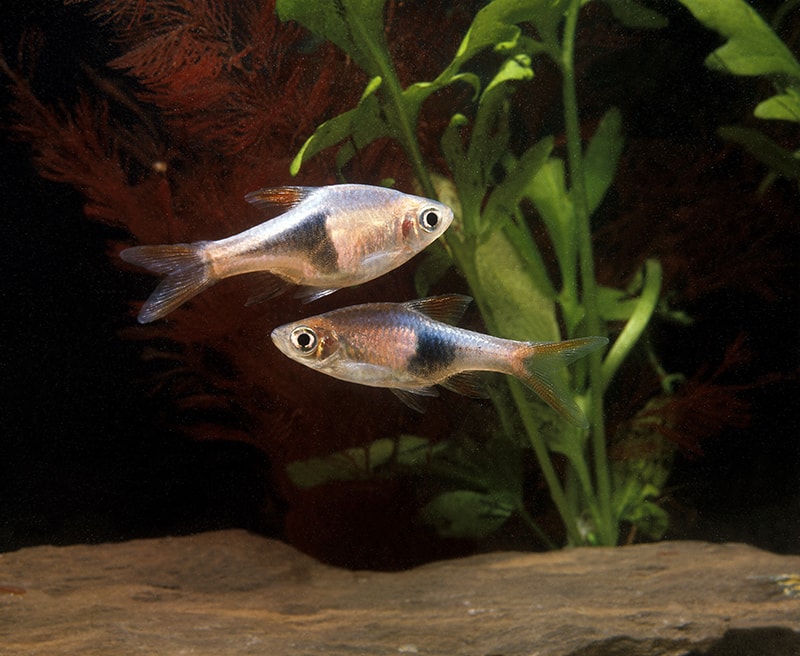
| Size: | 1–2 inches (2.5–5 cm) |
| Diet: | Omnivore |
| Minimum tank size: | 10 gallons (38 liters) |
| Care Level: | Medium |
| Temperament: | Docile |
Harlequin Rasboras are small fish, growing to around 2 inches in length. They are schooling fish that prefer to live in groups of up to 10 fish and they usually stay around the middle of the tank. The docile species can live with other species but they do like to have plants to hide in and around.
The peaceful nature of Harlequin Rasboras makes them good tank mates for Glofish Tetra. They also tend to live in slightly different areas of the tank. Harlequins are considered good beginner fish because they are adaptable and they can put up with some changes in water temperature.
6. Neon Tetra (Paracheirodon innesi)
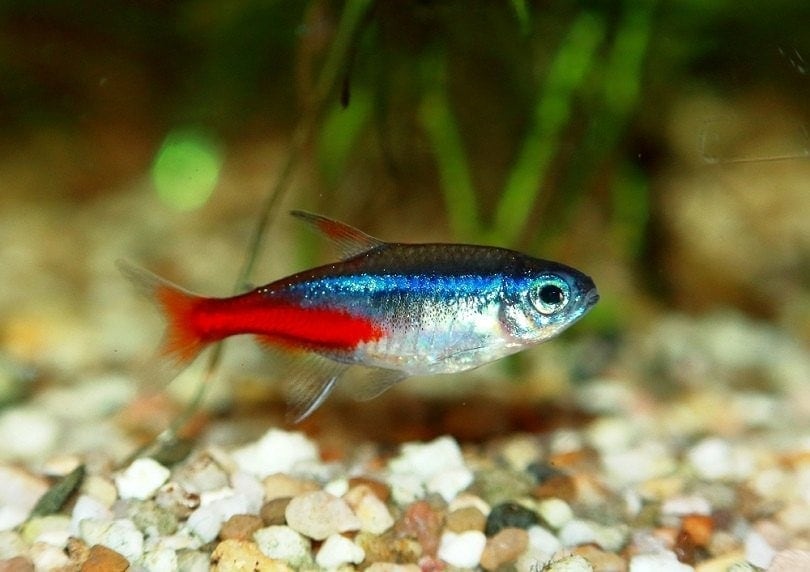
| Size: | 1–1.5 inches (2.5–4 cm) |
| Diet: | Omnivore |
| Minimum tank size: | 10 gallons (38 liters) |
| Care Level: | Medium |
| Temperament: | Tranquil |
Neon Tetras are the best match for Glofish Tetras because they are essentially the same fish, except for their physical appearance. This means they have the same water and tank requirements, eat the same foods, and they should get along with no territorial behavior or aggression displayed toward one another.
7. Platy (Xiphophorus maculatus)
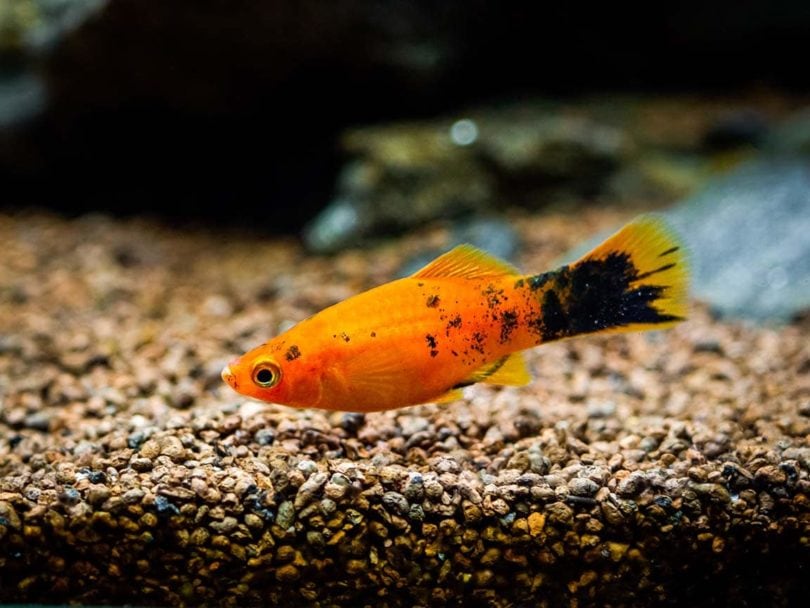
| Size: | 2-3 inches (5-8 cm) |
| Diet: | Omnivore |
| Minimum tank size: | 10 gallons (38 liters) |
| Care Level: | Easy |
| Temperament: | Peaceful, Social |
Platies are short, quite small fish. They do come in a variety of colors and patterns, though, and are a peaceful species that are pleasant to watch and easy to keep. They are adaptable, which means they can be forgiving of some changes in temperature and water change, although you should aim to provide ideal conditions for any species to thrive. Although adaptable, one thing that Platies do not thrive in is dirty water, so regular water changes and cleaning are important.
Platies and Tetras are generally friendly fish and the two species will live amicably together.
8. Silver Molly (Poecilia sphenops)

| Size: | 3–4 inches (7–10 cm) |
| Diet: | Omnivore |
| Minimum tank size: | 20 gallons (75 liters) |
| Care Level: | Easy |
| Temperament: | Peaceful, males can be aggressive when looking to mate |
The peaceful Silver Molly is a good beginner fish. It is low maintenance, gets along with other species, and eats just about anything including some of the algae in the tank. Different varieties of Mollies reach different sizes, and the Silver Molly will usually grow to around 4 or 5 inches in length.
Mollies do get along well with other fish and will peacefully with Glofish Tetras, as long as you provide them enough space. They can become aggressive if the tank is overpopulated so be careful of breeding rates and try to keep numbers at an optimal level.
9. Sunset Thicklip Gourami (Trichogaster labiosa)
| Size: | 3–4 inches (7–10 cm) |
| Diet: | Omnivore |
| Minimum tank size: | 20 gallons (75 liters) |
| Care Level: | Easy |
| Temperament: | Peaceful |
Sunset Thicklip Gouramis also make good beginner fish. They are sociable fish that come in a variety of colors from brown to red. They are forgiving of different water conditions but they prefer slow-moving water. And, while they can develop a hierarchical structure within their own group, they are not usually aggressive with one another.
The Gouramis are not aggressive with other fish, either, although they can be quite timid which makes them a target for more aggressive tankmates. This should be avoided.
10. Swordtail (Xiphophorus)
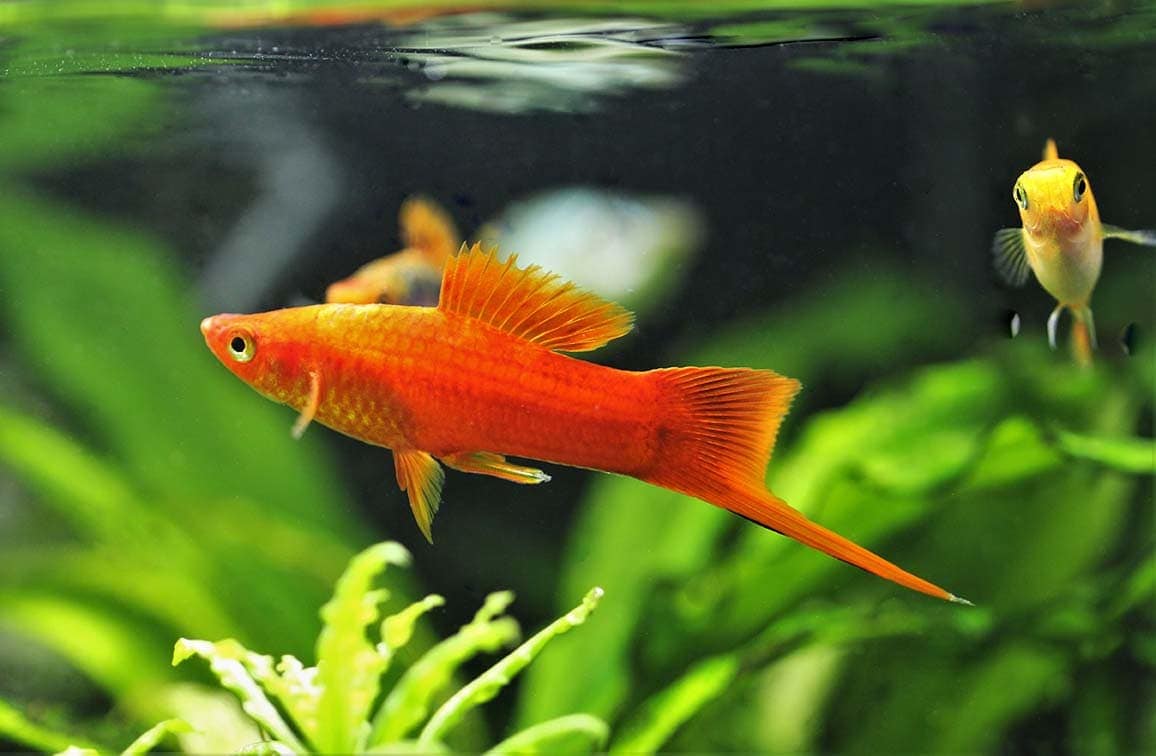
| Size: | 5–7 inches (12–18 cm) |
| Diet: | Omnivore |
| Minimum tank size: | 10 gallons (38 liters) |
| Care Level: | Easy |
| Temperament: | Adaptable |
The Swordtail is popular for its swordlike tail fin which gives the fish its name. The fin can be as long as the fish’s body but the female does not have this distinctive feature. The species enjoys living in a peaceful tank and will coexist with other species including Glofish Tetras.
There can be some aggression between two or more Swordfish males and if you keep multiple males, you should ensure there is enough food to prevent competition and enough females to prevent aggression.
What Makes a Good Tank Mate for Glofish Tetras?
Glofish Tetras are placid fish that are identical to Neon Tetras except in their physical appearance. That means they have the same water and tank requirements as Tetras. They also get along with other non-aggressive fish but prefer to live in schools of around half a dozen or so of their own kind.
The best tank mates are placid and non-aggressive and prefer water between 68 and 77 degrees Fahrenheit. Tetras do not have particularly floaty or frilly fins, which means they can even do well with fish that are prone to fin nibbling.
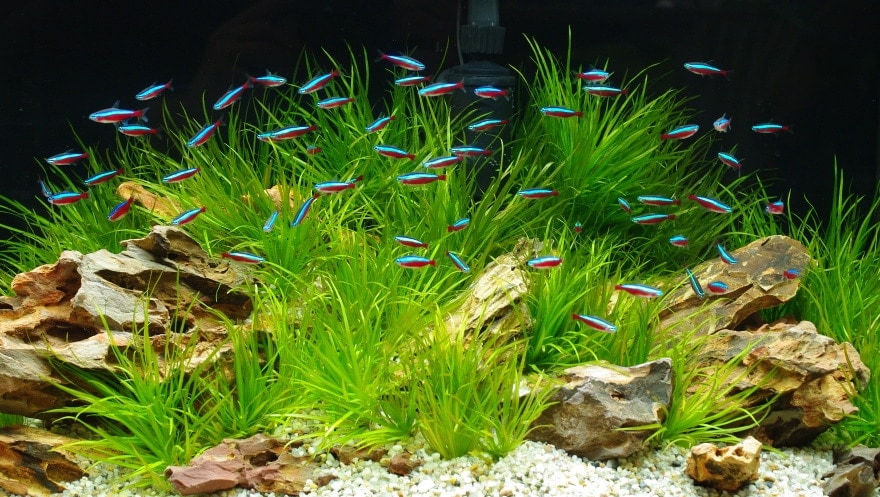
Where Do Glofish Tetras Prefer to Live in the Aquarium?
In the wild, Tetras live in dark areas of the water and amongst heavy vegetation. In tanks, they will typically reside at the bottom of the tank near the substrate. They do enjoy having plants and other areas to hide in amongst. They may venture away from the bottom of the tank sometimes.
Water Parameters
Although Glofish Tetras are genetically engineered fish that have never lived in the wild, they are basically the same as other Tetra species that are found in the Amazon Basin and throughout South America. They live in rivers and need similar conditions in a home setup.
The ideal water temperature for Glofish Tetras is between 68°F and 75°F. This means you might need an aquarium heater to help maintain a comfortable temperature for your fish. pH should be kept between 5.5 and 7, although this adaptable species may survive in water with slightly higher or lower pH values.
You will need to keep the water clean and fresh, however, which can be achieved with the help of algae-eating species and through regular water changes and good aquarium maintenance.
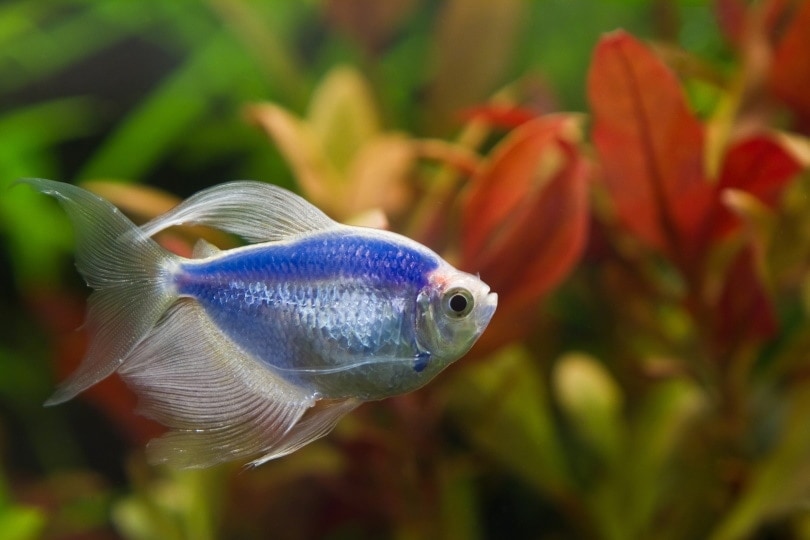
Size
Glofish Tetras are small fish that will usually only grow to around 1.5 inches in length. They are quite slender, too. While a single Tetra can be difficult to see, they prefer to live in schools which means owners can enjoy watching their schooling behavior which is even more evident in the Glofish variety because of their brighter colors.
Aggressive Behaviors
These placid fish rarely show aggressive tendencies, either with their own kind or with other species. However, this same placid nature can put them at risk when sharing a tank with more aggressive fish. As such, you should only house Glofish Tetras with other, similarly placid species.
3 Benefits of Having Tank Mates for Glofish Tetras in Your Aquarium
- Improved Tank Environment – Tetras prefer clean water and living conditions, which means the tank needs good maintenance and regular water changes. While they can’t fully replace water changes, fish like Catfish species can help reduce algae levels and control nitrites.
- Companionship – Tetras are sociable fish. They like to live in schools with other Tetras, but they can also enjoy the company of other placid fish species. However, take care that you do not have too many fish in one tank. They need enough space to swim and get away from one another. An overcrowded aquarium can cause stress in its inhabitants.
- Greater Visual Appeal – Glofish Tetras are beautiful and unusual. Combining them with other species of fish can provide a beautiful aquarium setup with a huge visual appeal.
Conclusion
Glofish Tetras are quite unique. They were genetically engineered to help identify pollutants in the water, but their striking look meant they soon garnered a lot of interest in the fish-keeping world. Eventually, the fish became available for home aquarists along with various other Glofish species.
Glofish Tetras are not visually unique but they are pretty, placid, and generally easy to care for. This makes them popular with fish keepers, although you should check local laws and statutes because they remain illegal in some states and some countries around the world.
The best tank mates for Tetras are those that are as placid as the Glofish and that enjoy the same water and tank conditions. This includes Neon Tetras, which are basically the same species of fish, as well as some catfish species like the Bristlenose Pleco. Make sure your tank is big enough for all the fish you house, however, because an overpopulated tank can cause stress and illness.
Featured Image Credit: Ibnu Amin, Shutterstock

